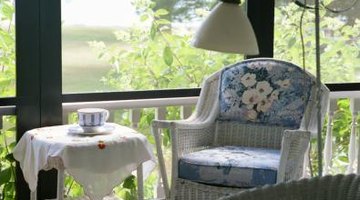Can You Heat a Three-Season Sunroom With a Gas Fireplace?
A three-season sunroom can be a versatile addition to the home in terms of style and comfort. Many sunrooms are composed primarily of glass and boast nearly airtight construction. Therefore, heating options must be vented to the outdoors. A direct-vent or B-vent gas fireplace will suit a three-season sunroom.
Gas Fireplace Operation and Heat Production

A gas fireplace, like any other fireplace, requires oxygen to aid combustion. It also needs a way to exhaust byproducts from the flame. In addition, whether the firebox, or combustion chamber, is open or closed impacts heating efficiency.
Direct-Vent Fireplace
A direct-vent gas fireplace is a quality choice to heat a three-season sunroom. It features a closed firebox, which means it does not require room air to fuel the fire. The direct-vent design draws air from outdoors into the firebox via a pipe. It also exhausts byproducts from the fire to the outdoors via a separate pipe.
Relative to aesthetics, the direct-vent design requires no chimney, so it offers no vertical obstruction to interrupt visual flow. The vent pipes are installed through an outside wall of the home. Positioning the fireplace against one wall of the sunroom allows for ease of installation and tidy use of space.
Because of its closed firebox, the direct-vent gas fireplace heats more efficiently. In an enclosed, relatively airtight room, it will likely not need to be operated at high temperatures for long. Less operating time may mean lower energy costs.
B-Vent Fireplace
A B-vent, or natural vent, gas fireplace features a double-walled metal flue that functions like a traditional masonry chimney. It is a fully vented design, which means it draws air from the room to feed the fire. This type of fireplace can work in a three-season sunroom but suffers from design and heating efficiency drawbacks.
Because the B-vent is installed through the roof, the vertical piping interrupts the flow of the space. In addition, B-vent flues extrude through the roof and must adhere to rooftop clearance restrictions relative to exterior walls, trees and other combustibles. The logistics of installing a B-vent fireplace in a three-season sunroom may prove impractical or insurmountable.
Moreover, in fully vented fireplace designs, a great deal of heat escapes up the flue itself, diminishing heat output to the room. Installing a floating firebox, which acts to partially enclose the combustion chamber, can improve matters.
Ventless Fireplace
A ventless fireplace is a poor choice to heat a three-season sunroom. While it is true that heat output is excellent, the ventless system exhausts fumes -- including carbon monoxide, among other gases -- directly into room air. In an airtight room, the potential for poisoning is high. Though carbon monoxide levels may not grow to a point where they set off an alarm, a constant, low-level presence of the noxious gas may still be present. For children, the elderly and pets especially, this can prove harmful.
References
Writer Bio
D. Laverne O'Neal, an Ivy League graduate, published her first article in 1997. A former theater, dance and music critic for such publications as the "Oakland Tribune" and Gannett Newspapers, she started her Web-writing career during the dot-com heyday. O'Neal also translates and edits French and Spanish. Her strongest interests are the performing arts, design, food, health, personal finance and personal growth.
Photo Credits
- Creatas Images/Creatas/Getty Images
More Articles



